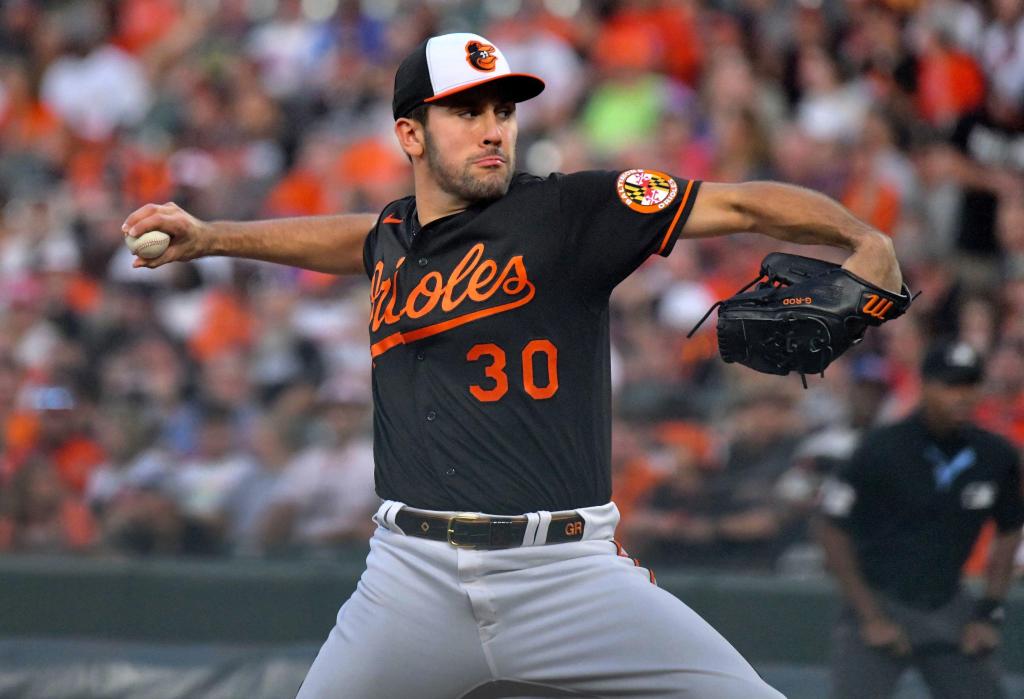
Here’s why the Orioles are likely moving to a six-man starting rotation

After the Orioles acquired Jack Flaherty minutes before last week’s trade deadline, Mike Elias said Baltimore’s rotation doesn’t have much of a “hierarchy.”
While the Kyles are the rotation’s leaders — Gibson for his veteran presence, Bradish for his sparkling 3.19 ERA — the difference in expected outcomes doesn’t vary much among the group.
Baltimore didn’t acquire a traditional No. 1 starter in the offseason or at the deadline, and compared with the other top teams in the majors, they don’t have a bonafide ace. That fact, though, hasn’t mattered much so far this season, as Baltimore has the best record in the American League and enters its nine-game road trip out west three games ahead of the Tampa Bay Rays atop the AL East.
With 47 games remaining, the Orioles’ rotation is expected to look a bit different than their competitors in a new way. Manager Brandon Hyde said Thursday that left-hander Cole Irvin, who had been in a long relief role, would start Saturday as the first trial in testing out a six-man rotation.
“We’re going to try to give guys extra days as we go along here, try to keep our starting pitching as fresh as possible,” Hyde said.
The fact that the Orioles’ rotation lacks a “hierarchy” could be one of the reasons a six-man rotation is an option. There are no top-line workhorses who would miss a few starts under the elongated structure.
“We’ve got some young guys that are doing really, really well,” Elias, the club’s executive vice president and general manager, said last week. “I don’t really care what the order of our rotation is. If we’re fortunate enough to get in the playoffs and we see who our opponent is and how the matchup is, we’ll set the rotation order at that point. But right now, we’ve got more than five guys with Flaherty in the fold … and that’s, I think, what it takes.”
Before spring training, when Elias said there were a dozen pitchers competing for the rotation, he added a six-man group was a consideration given the youth of its starting corps. Tyler Wells, who is now in the minors after a stellar first half, is 28 years old. Dean Kremer and Jack Flaherty are 27. Bradish is 26. Grayson Rodriguez is 23. Irvin, 29, and Gibson, 35, are the only starters on the 40-man roster who entered the season with two campaigns of 30-plus starts.
But youth isn’t the problem as much as experience with large workloads. Four of those starters — Wells, Kremer, Bradish and Rodriguez — have either passed or are nearing their single-season innings highs. They’ve already had to send one (Wells) down to Double-A for what Hyde called a “reset” as it appeared the wear and tear of a long season might have been impacting the 6-foot-8 right-hander.
The move to a six-man rotation allows extra days off — like the two Bradish will get before his start Sunday — to help keep the young group sharp, Hyde said.
“We have a long stretch in September after a couple off days at the end of this month. We’re doing the best as we can to monitor innings and workload and keep these guys as healthy as possible these next [47] games,” he said.
Wells was the Orioles’ best starter in the first half, but he struggled with command in his three starts after the All-Star break. In late July, the club sent him to Double-A for a “breather,” Hyde said, with the hopes of him returning down the stretch. At 117 innings between the majors and minors this year, Wells will likely pass his single-season high set back in 2018 (119 1/3) when he pitches for the Baysox on Saturday. He didn’t pitch for two years after undergoing Tommy John elbow reconstruction surgery in 2019, but was a reliever for the Orioles as a Rule 5 draft pick in 2021 and a starter last year. Wells is on a seven-day rest schedule after his starts rather than the typical system that provides four or sometimes five days rest.
“He feels really good. I think this break was huge for him,” Hyde said. “Doing a lot of mechanical work, backing off his throwing, things like that just to hopefully make it easier to be a big part of our team down the stretch.”
Bradish and Kremer were also big league starters for most of 2022, but they both had stints on the injured list that slightly limited their workloads. Bradish is about 25 innings away from the 145 1/3 innings he pitched between the majors and minors in 2022. Kremer, who is tied with Gibson for the team-lead with 11 wins, is at 132 innings and should surpass his high-water mark set last year (134 1/3) in his next start.
“The three of us that are kind of approaching, that are closely monitoring our workload and keeping that kind of in the back of our head,” Kremer said. “It’s really about the in-between and making sure you feel good on Day 5.”
Perhaps the most important rotation member to track is Rodriguez, the hard-throwing right-hander who entered the year ranked by Baseball America as the second-best pitching prospect in the sport. At 115 1/3 innings between Triple-A Norfolk and Baltimore, Rodriguez has already eclipsed his single-season high of 103 frames set in 2021. He missed three months last year with a right lat muscle strain. If he remains in the rotation for the remainder of the season, he would likely end with between 150-170 innings.
While Flaherty’s workload isn’t as concerning given his past success and joining Baltimore as a two-month rental, he’s surpassed 100 frames this year for the first time since 2019 and is on pace to throw more innings this season (approximately 165) than he did in the majors from 2020 to 2022 combined (154 2/3).
While lacking a “hierarchy” could make the move easier, the fact that the Orioles had Irvin, a lefty who was a dependable league-average starter the previous two seasons for the Oakland Athletics, available to move from the bullpen is a luxury. Irvin struggled to begin his Orioles tenure and was sent down to the minors, but he has a 3.60 ERA since he was recalled in mid-June and a 2.66 ERA in his five starts during that stretch.
“You know, best-case scenario, everybody stays healthy, the bullpen stays intact, I think we would definitely look into that, giving Cole more starts,” Hyde said. “You just kind of never know and things happen quickly. That’s kind of our plan right now is to insert Cole there, just give guys extra days.”
A six-man rotation isn’t without its drawbacks, of course. During spring training, Hyde listed two main reasons it’s not ideal to have six starting pitchers. First, it puts extra strain on the bullpen. With MLB’s roster restrictions limiting the number of pitchers on a 26-man roster to 13, having six starters means one fewer arm in the bullpen. That could pose a challenge — and perhaps the reason the six-man plan is abandoned — as the Orioles’ relief corps, even the All-Star duo of Yennier Cano and Félix Bautista, has started to show cracks. Hyde also said it’s difficult to manage a smaller bullpen with the league’s stricter rules around optioning and recalling players to and from the minors.
But the six-man could also be what’s best for the club in September, and not just from a workload standpoint. With the organization’s hope that Wells can rejoin the rotation and the potential return of left-hander John Means, it’s possible adding one (or both) of those pitchers to the group provides a late-season boost.
Means, the Orioles’ best starter during the rebuild, began his minor league rehabilitation assignment Thursday with Double-A Bowie. In his first game action since tearing his ulnar collateral ligament and undergoing Tommy John elbow reconstruction surgery in April 2022, Means pitched two scoreless innings with two strikeouts and no walks.
“We’re going to kind of see where we are,” Hyde said about the possibility of Wells and Means returning. “After Tyler throws this next time, it’s pretty much we’re kind of coming down the stretch here, so we’re kind of day to day a little bit on everything, waiting to see when guys are going to be ready. But as of right now, we want to give some of our rotation guys some extra days.”
()




